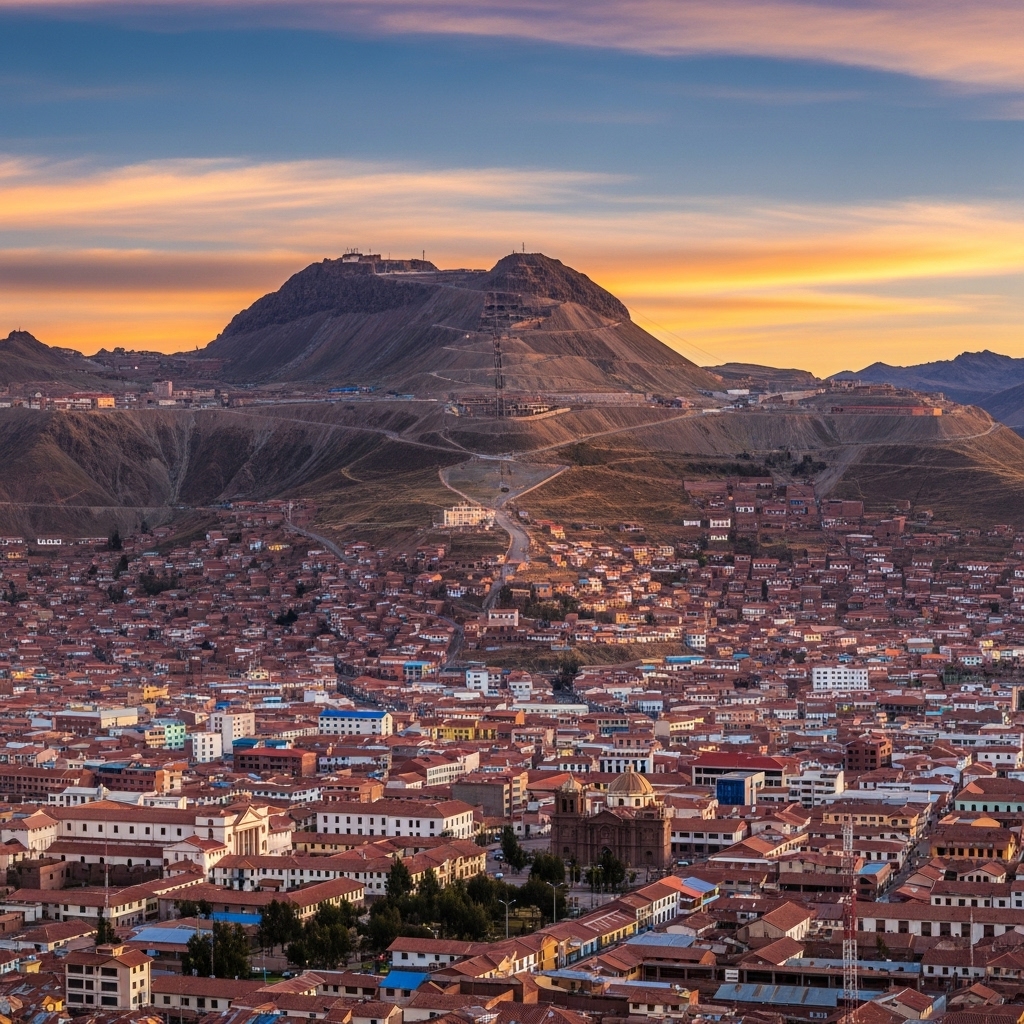
Potosi: A City Etched in Silver – Travel Guide, Attractions, and History
- Location: Bolivia
Planning Your Trip to Potosi
Essential Travel Information
Country and State
Bolivia
Timezone
GMT -4
Languages Spoken
Spanish, Quechua
Currency
Boliviano (BOB)
Potosi Weather and Climate: A Month-by-Month Guide
Potosi’s high altitude creates a semi-arid climate. Understanding the weather patterns will help you pack accordingly.
- January-February: Rainy season, cooler temperatures (average 10-15°C/50-59°F). Expect some showers.
- March-May: Drier, temperatures start to drop (average 5-10°C/41-50°F). Pleasant for exploring.
- June-August: Coldest and driest months, temperatures often below freezing at night (average 0-5°C/32-41°F). Bring your warmest layers!
- September-November: Temperatures gradually rise, drier conditions continue (average 8-15°C/46-59°F). A great time to visit.
- December: Warmer and start of the rainy season.
Potosi City Overview: History, Culture, and Altitude
Potosi, one of the highest cities in the world, commands attention at over 4,000 meters (13,000 feet). Its story is inseparable from Cerro Rico, the “rich mountain” that once fueled the Spanish Empire’s coffers with silver. Founded in the 16th century, Potosi rapidly grew into one of the largest and wealthiest cities in the Americas. This boom left behind impressive colonial architecture and a layered history of both immense prosperity and intense exploitation. Today, Potosi stands as a UNESCO World Heritage Site, a testament to its unique fusion of Spanish colonial and indigenous cultures. Despite the altitude and challenging climate, the city thrives as a vibrant center of Bolivian life, beckoning visitors to delve into its history and admire its stunning surroundings. A visit to Potosi offers a fascinating look into a bygone era, showcasing the grandeur of its silver rush alongside the resilience of its indigenous communities. Book your Potosi tours and activities here!
Best Time to Visit Potosi: Pros and Cons
Choosing the right time to visit Potosi depends on your tolerance for cold and crowds. Here’s a breakdown to help you decide:
- April-May/September-October:
- Pros: Drier weather, milder temperatures compared to the winter months, fewer crowds than the peak summer season. Ideal for sightseeing.
- Cons: Temperatures can still be chilly, especially at night. Pack layers!
- June-August:
- Pros: Driest weather, clear skies. Perfect for photography.
- Cons: Very cold temperatures, potential altitude sickness exacerbated by the cold. Be prepared for freezing nights.
How to Get to Potosi & Visa Requirements
Transportation Options
- Flights: The closest major airport is in Sucre (SRE), approximately a 3-hour bus ride from Potosi. Flights connect Sucre to other major Bolivian cities. Search for affordable flights to Sucre here.
- Trains: Train travel to Potosi is limited. The most common route connects Oruro to Uyuni, with bus connections to Potosi from both cities.
- Buses: Buses are the most frequent and affordable way to reach Potosi from other Bolivian cities. Several companies offer daily services.
Visa Information
Visa requirements vary based on your nationality. Many nationalities can enter Bolivia without a visa for a limited period (usually 30 or 90 days). It’s crucial to confirm the latest visa regulations with the Bolivian embassy or consulate in your country before your trip.
Airport Transfers
From Sucre airport, take a taxi or pre-booked shuttle to the bus terminal, then catch a bus to Potosi. Bus services are frequent and budget-friendly. Pre-book your airport transfer here for a hassle-free arrival.
Potosi: A City of Silver and Stories
Fun/Historical Fact or Story
Cerro Rico, the mountain that gave Potosi its fame, held so much silver that legend says a bridge of silver could have been built from Potosi to Spain. A darker side of the story reveals that a bridge of bones could also have been built from Potosi back to Spain, reflecting the immense suffering and death of indigenous miners in the mines.
Famous Personalities from Potosi
- Juan del Valle y Caviedes (1645-1698) – a satirical poet of the Spanish Colonial period.
Top 10 Attractions in Potosi
- Casa de la Moneda (National Mint of Bolivia)
- Description: A historic mint where coins were produced for the Spanish Empire. Now a museum showcasing the minting process and colonial history.
- Address: Calle Ayacucho esq. Bolívar, Potosi
- Cerro Rico
- Description: The “rich mountain” that fueled Potosi’s silver boom. Guided tours of the mines are available. Book your mine tour here.
- Address: Cerro Rico, Potosi
- Convento Museo de Santa Teresa
- Description: A beautifully preserved colonial convent showcasing religious art and historical artifacts.
- Address: Calle Chichas 45, Potosi
- Plaza 10 de Noviembre
- Description: The main square of Potosi, surrounded by colonial buildings and historical landmarks.
- Address: Plaza 10 de Noviembre, Potosi
- Iglesia de San Lorenzo de Carangas
- Description: A stunning baroque church adorned with intricate stone carvings.
- Address: Calle La Paz, Potosi
- Arco de Cobija
- Description: A historic archway that once marked the city’s entrance.
- Address: Calle Cobija, Potosi
- Museo Universitario
- Description: A university museum displaying minerals, fossils, and artifacts related to the region’s geology and history.
- Address: Calle Bolívar 440, Potosi
- Lagunas de Kari Kari
- Description: A series of high-altitude lakes offering breathtaking views and hiking trails.
- Address: Kari Kari, Potosi (located outside the city center)
- Iglesia de San Francisco
- Description: A historic church with a unique combination of architectural styles.
- Address: Calle Tarija, Potosi
- Mirador de San Bartolomé
- Description: A viewpoint offering panoramic views of Potosi and the surrounding landscape.
- Address: Cerro San Bartolomé, Potosi (located outside the city center)
Potosi’s Hidden Gems
- Mercado Central
- Description: A bustling local market where you can immerse yourself in the daily life of Potosinos and sample local delicacies.
- Address: Calle Bolívar, Potosi
- Balneario de Tarapaya (Termas de Tarapaya)
- Description: Natural hot springs located a short distance from Potosi, offering relaxation and therapeutic benefits. Book a tour to the hot springs here.
- Address: Tarapaya, Potosi (located outside the city center)
- Casa del Artesano
- Description: A cooperative of local artisans selling handmade crafts and textiles.
- Address: Calle Bolívar 677, Potosi
Local Festivals & Events in Potosi
- Festival de San Bartolomé (August)
- Description: A vibrant religious festival featuring traditional dances, music, and processions.
- Aniversario de Potosi (November 10)
- Description: Celebrations commemorating the founding of Potosi, with parades, cultural performances, and fireworks.
- Carnaval (February/March)
- Description: Celebrations that often spill over from Oruro, the Bolivian Capital of Folklore.
Day Trips & Nearby Attractions from Potosi
- Sucre (Approx. 3 hours by bus)
- Description: The constitutional capital of Bolivia, renowned for its well-preserved colonial architecture and historical importance. Book a day trip to Sucre here.
- Uyuni Salt Flats (Approx. 6-7 hours by bus)
- Description: The world’s largest salt flat, offering breathtaking landscapes and surreal photo opportunities. Book a tour to the Uyuni Salt Flats here.
Photography Spots & Instagrammable Places in Potosi
- Cerro Rico: Capture the iconic silhouette of the mountain dominating the city skyline.
- Casa de la Moneda: Photograph the impressive colonial architecture and historical details.
- Plaza 10 de Noviembre: Frame the colonial buildings surrounding the main square, especially during sunset.
- Lagunas de Kari Kari: Capture the stunning reflections on the surface of the high-altitude lakes.
- Iglesia de San Lorenzo de Carangas: Photograph the intricate stone carvings and baroque details.
Where to Stay & Getting Around Potosi
Recommended Length of Stay
Plan for 3-4 days to thoroughly explore the city’s main attractions and take a mine tour. Book your Potosi accommodation here.
Top Places to Stay in Potosi
Budget-Friendly Options
- Hostal Casa Blanca Potosi – Calle Oruro # 374, Potosi
- Hostal Patrimonio – Calle Bolivar 759, Potosi
- Hostal Amigo – Calle Oruro # 367, Potosi
Mid-Range Hotels
- Hotel Coloso Potosi – Avenida Maestro Nº 500, Potosi
- Hotel Santa Maria Magdalena – Calle Matos 175, Potosi
- Hotel Museo Cayara – Calle Bolivar 036, Potosi
Luxury Hotels
- Hotel Camino Real Potosi – Calle Uyuni 370, Potosi
- Sumaj Hotel – Calle Oruro 333, Potosi
Getting Around Potosi: Transportation Guide
- Public Transport: Minibuses (micros) are the primary mode of public transport. They are affordable and cover most areas of the city.
- Taxis: Taxis are readily available and can be hailed on the street or booked through your hotel. Always negotiate the fare beforehand.
- Walking: The city center is relatively compact and walkable. Be prepared for the high altitude and uneven streets.
Preparing for Your Potosi Adventure
What to Pack for Potosi
- Warm Clothing: Layers are crucial, including a warm jacket, sweater, hat, and gloves, especially during the winter months.
- Comfortable Shoes: Sturdy shoes are essential for navigating uneven streets and exploring the mines.
- Sunscreen and Sunglasses: The high altitude means intense sun exposure.
- Altitude Sickness Medication: Consult your doctor about medication or remedies for altitude sickness.
- Bolivian currency: While card payments are becoming more common, many establishments still prefer cash.
- Small backpack: A lightweight backpack to carry water, snacks, sunscreen, and other essentials.
Useful Apps for Traveling in Potosi
- Maps.me: Offline maps for navigation.
- Google Translate: For translating Spanish.
- XE Currency Converter: For currency exchange rates.
- Entel Bolivia: (if you buy a local SIM) To top up credit.
Local Customs, Safety Tips & Cultural Etiquette in Potosi
- Do:
- Drink plenty of water to stay hydrated.
- Walk slowly and take breaks to acclimatize to the altitude.
- Respect local customs and traditions.
- Learn a few basic Spanish phrases.
- Bargain respectfully in markets.
- Don’t:
- Overexert yourself on the first few days.
- Drink tap water.
- Take photos of locals without their permission.
- Leave valuables unattended.
- Scams to Avoid:
- Be cautious of overly friendly strangers offering unsolicited help.
- Count your money carefully when making transactions.
- Respectful Behavior:
- Dress modestly when visiting religious sites.
- Avoid public displays of affection.
Potosi: Food, Fun & Finds
Top Restaurants in Potosi
- El Fogon: (Traditional Bolivian cuisine, Moderate) – Calle Bolívar 756, Potosi. Enjoy hearty Bolivian dishes in a cozy setting.
- 4060 Restaurant & Bar: (International cuisine, Moderate) – Hotel Camino Real, Calle Uyuni 370, Potosi. Offers a diverse menu with great views.
Must-Try Dishes in Potosi
- Pique Macho: A hearty dish of beef, sausage, potatoes, onions, peppers, and a fried egg.
- Salteñas: Savory pastries filled with meat, vegetables, and a slightly spicy sauce.
- Sopa de Maní: Peanut soup, a traditional Bolivian soup made with peanuts, vegetables, and meat.
Nightlife & Entertainment in Potosi
- El Tambo: (Bar, Live music) – Calle Bolívar 760, Potosi. A popular spot with local beer and live bands on weekends.
What to Buy: Souvenirs & Markets in Potosi
- Mercado Central: (Local market) – Calle Bolívar, Potosi. Find a variety of local crafts, textiles, and souvenirs.
- Casa del Artesano: (Handmade crafts) – Calle Bolívar 677, Potosi. Purchase unique items made by local artisans.




